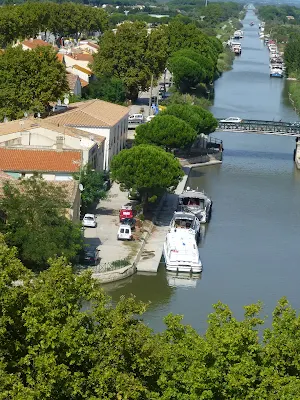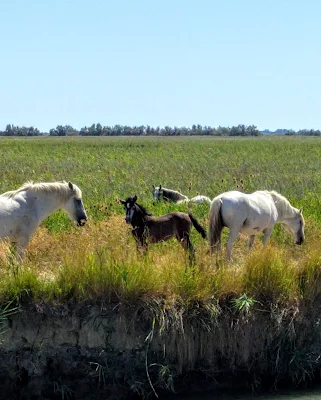 |
| Chateau de roi René, Taracson - 12th/15th century |
Our overnight mooring on a small jetty near Saint Gilles was to be our final stop on the French canals for this year. We still had a long way to travel but it would all be by river; firstly the Petite Rhone, then the Rhone and finally the Saone (with a short side trip onto the Seille). Excluding the Seille, a distance of about 500km and all against the current. By this time it was mid August. Summer continued to be very hot and dry so we were anticipating conditions would be as favourable as they would ever be but you never can tell.
 |
| Final night on the canals - near Saint Gilles |
The first of the 19 locks ahead of us (onto the Petite Rhone) is 190m long x 11.40 - the same dimensions as the locks on the Rhone itself. However, unlike the others the change in water level was virtually imperceptible. From the lock to the Rhone proper is 21 km, a little over 2 hours. We saw no one on the river bar a couple of small fishing boats. The Petite Rhone joins the Rhone quite close to Arles. We had toyed with the idea of going there but from what we had heard, mooring safely is a a problem so, when we came to the junction of the big river, we turned left and upstream.
Finding places to stop on a river is always a problem. The Rhone is a busy waterway carrying large commercial barges and river cruise ships. Commercial traffic has priority, of course, not only at locks but also at many quays. The nights' stops required planning - not one of our fortes but necessary.
 |
| Approaching the first lock on the Rhone |
 |
| In we go - on our own |
There was none of the usual lazing around all morning, drinking numerous cups of tea whilst wasting time keeping up with Brexit shenanigans on our new, whizz bang, internet deal then deciding to saunter off after lunch. No, we were up and away first thing (well by around 10-ish) with a stopping place in mind and a back-up, if possible, in case the first option was taken. We were also hoping to try and visit some of the places we had missed out on our our trip south.
 |
| Aramon at dawn - view from the porthole |
That first evening though we found ourselves once again at Aramon where we'd spent almost 2 weeks 5 years ago, waiting for the elusive courier to pick up our non-functional, expensive a/c unit and return it to the UK. This was the long running saga of our trip south (spoiler, he never caught up with us until Toulouse).We'd had a very enjoyable stay there though, along with a great group of boaters.
We had hoped to go on to Avignon but it had taken a little longer than anticipated at the first of the huge locks at Beaucaire and we didn't want to risk not finding a space at the popular city late in the day.
Sadly, the flamboyant ex fighter pilot, port captain Olivier, has departed and the port is now run by the commune which has doubled the price - now 40 euros for one night. We were the sole visitng boat. We left first thing the next morning.














































